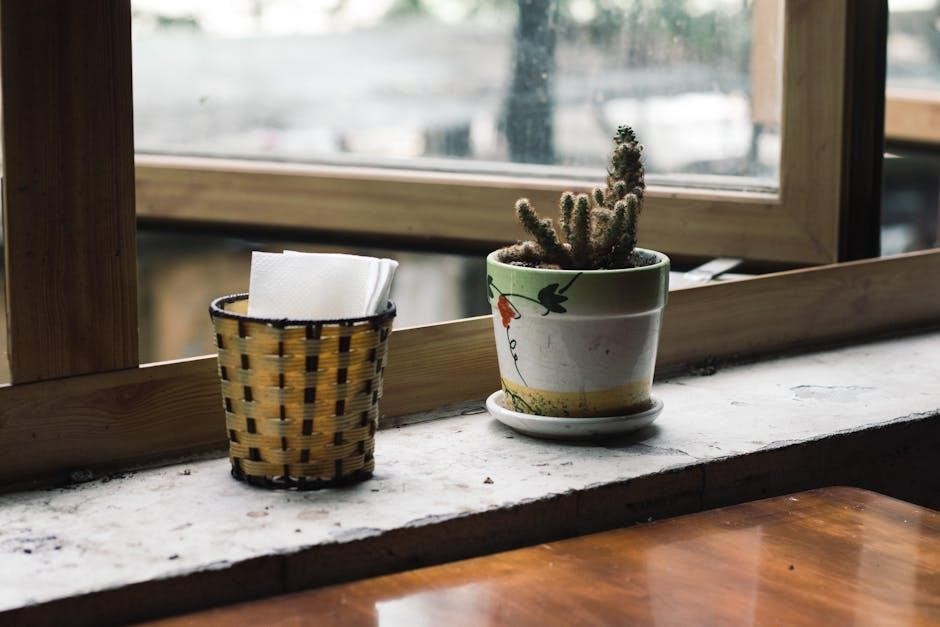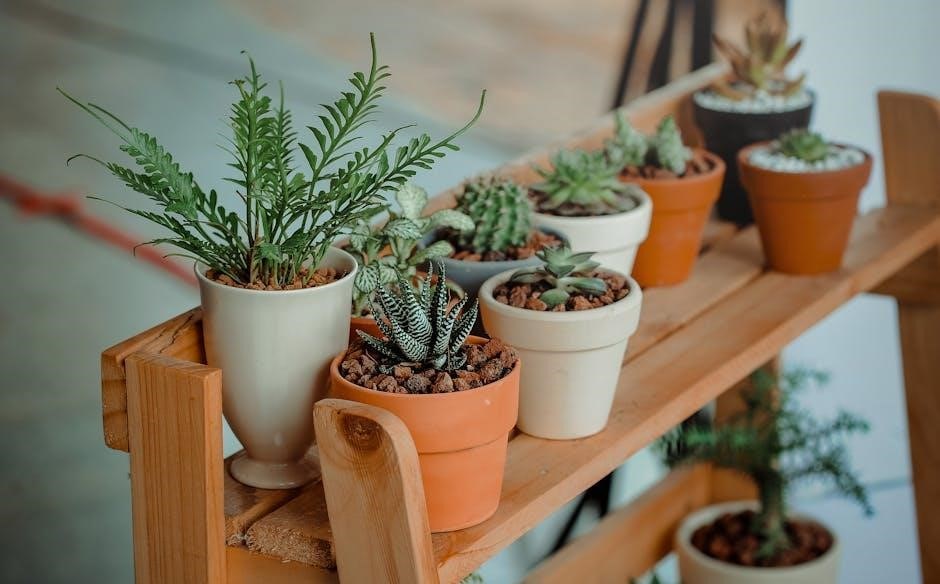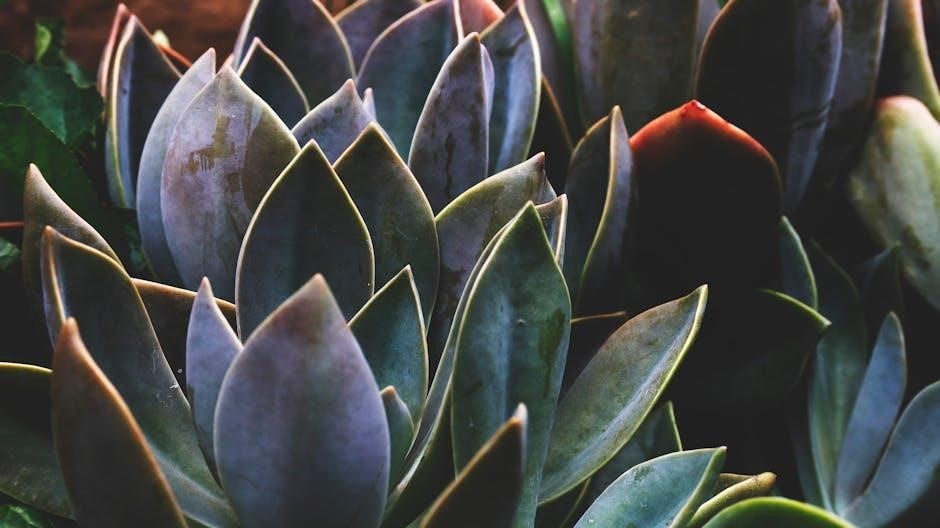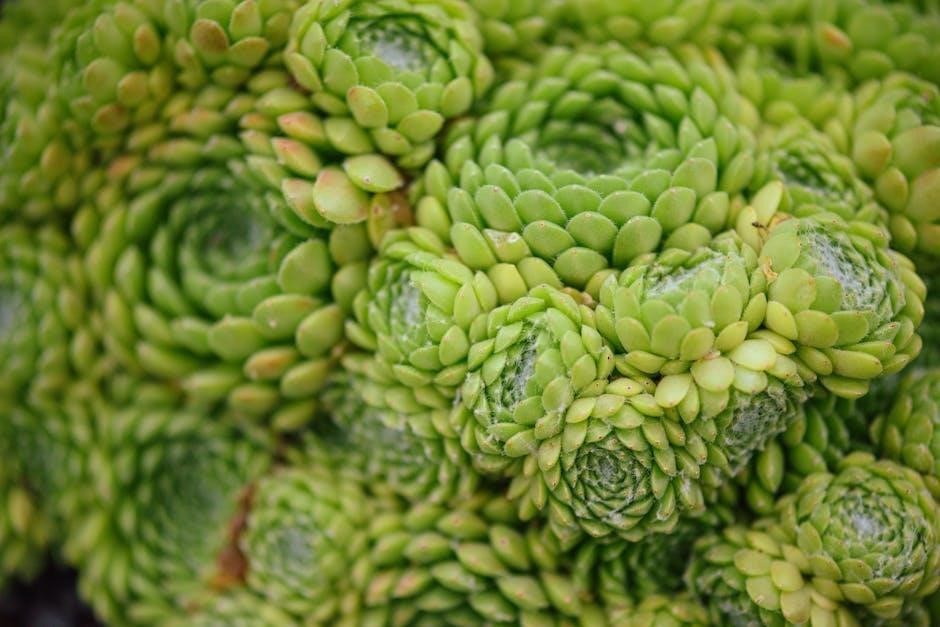
Cacti are fascinating, low-maintenance plants native to the Americas, known for their thick, water-storing stems and sharp spines. These unique succulents thrive in arid environments and are popular houseplants worldwide, including species like the Christmas cactus.
History of Cacti
Cacti have a rich and ancient history, with origins tracing back millions of years to the Americas. These unique plants evolved as adaptations to arid environments, developing thick stems to store water and spines for protection. Indigenous peoples utilized cacti for food, medicine, and ceremonial purposes, with species like the prickly pear being a vital resource. The first recorded encounters by Europeans date back to the 16th century, sparking curiosity and cultivation. By the 19th century, cacti became popular among botanists and collectors, leading to widespread distribution worldwide. Today, cacti are cherished for their beauty, resilience, and low-maintenance requirements, making them a staple in modern gardening and interior design. Their enduring appeal lies in their ability to thrive in harsh conditions, symbolizing survival and adaptability.
Cultural Significance of Cacti
Cacti hold profound cultural and symbolic meaning across various societies. In the American Southwest, they are iconic symbols of resilience and the desert landscape, often featured in art, folklore, and literature. Many Indigenous cultures have revered cacti for centuries, using them for food, medicine, and spiritual rituals. The prickly pear cactus, for instance, is a staple in Mexican cuisine and folklore. In modern times, cacti have become popular motifs in home decor, representing minimalism and endurance. Their unique appearance has inspired architects, designers, and artists worldwide. Additionally, cacti symbolize survival and adaptability, making them a popular choice for gifts and landscaping. Their enduring appeal lies in their ability to thrive in harsh conditions, reflecting human resilience and the beauty of nature. This cultural significance has cemented cacti as more than just plants—they are symbols of heritage, strength, and the natural world.

Popular Cactus Species
Some popular species include the vibrant Christmas cactus, the resilient prickly pear, and the flowering Echinopsis, each offering unique beauty and adaptability to various environments and care routines.
Christmas Cactus Care
Christmas cacti are popular for their vibrant flowers and low-maintenance requirements. To encourage blooming, provide 12-14 hours of darkness daily in fall. Place them in bright, indirect light but avoid direct sunlight. Water when the top inch of soil feels dry, reducing frequency in winter. Use well-draining soil to prevent root rot. Fertilize during the growing season (spring-fall) with a balanced fertilizer. Prune after flowering to promote new growth. Propagate by cutting healthy stem segments and allowing them to dry before planting. Keep humidity moderate and maintain temperatures between 60-70°F (15-21°C). Repot every 2-3 years in spring. With proper care, Christmas cacti can bloom profusely and remain a stunning addition to your home during the holiday season.
Prickly Pear Cactus Guide
The Prickly Pear cactus (Opuntia) is a popular, versatile species known for its flat, round pads covered in sharp spines. Native to the Americas, it thrives in well-draining soil and full sun, making it ideal for outdoor gardens in warm climates. Water sparingly, allowing soil to dry completely between waterings, as overwatering can lead to root rot. Prickly Pear cacti are relatively low-maintenance and can tolerate some frost. They are easily propagated by dividing pads, ensuring each segment has enough tissue to grow. This cactus is not only ornamental but also edible, with pads (nopales) used in cuisine and fruits (tunas) eaten raw or made into jams. Regular pruning helps control size and encourages healthy growth. With proper care, Prickly Pear cacti can grow robustly and provide beauty and utility for years.
Echinopsis Cactus
Echinopsis is a genus of cacti widely admired for their vibrant, funnel-shaped flowers and striking appearance. These cacti are popular among collectors and gardeners due to their ability to produce spectacular blooms, often in shades of pink, red, yellow, and white. Native to South America, Echinopsis species typically grow as cylindrical or spherical plants, covered in ribs and spines. They are relatively small in size, making them a great choice for indoor and outdoor gardens.
Caring for Echinopsis involves providing bright, indirect sunlight and well-draining soil to prevent root rot. Water sparingly, allowing the soil to dry completely between waterings; Fertilizing during the growing season promotes healthy growth and flowering. With proper care, Echinopsis cacti can thrive and showcase their stunning blooms, making them a rewarding addition to any cactus collection.

Cactus Care Tips
Cacti are low-maintenance plants requiring well-draining soil, minimal watering, and bright sunlight. Regular fertilization during the growing season supports healthy growth and blooming, ensuring your cacti thrive indoors or outdoors.
Watering Techniques
Watering cacti requires careful attention to avoid overhydration. The best method is the “soak and dry” technique, where the soil is thoroughly watered and then allowed to dry completely between sessions. During the growing season, cacti may need watering once a week, but in winter, reduce frequency to every four to six weeks. Always check the soil moisture by inserting a finger up to the first knuckle before watering. Overwatering is a common mistake that can lead to root rot and other issues. Ensure the pot has drainage holes to prevent waterlogged soil. Avoid getting water on the plant’s stem or leaves to minimize the risk of fungal diseases. If the cactus starts turning brown, it may indicate excessive watering. Adjust your schedule based on the plant’s response and environmental conditions, such as humidity and temperature, to ensure optimal health.
Sunlight Requirements
Cacti thrive in bright, direct sunlight, typically requiring at least 12 hours of light per day for optimal growth. Placing them near a south-facing window or outdoors in full sun is ideal. However, some species can tolerate bright indirect light, though they may not bloom as profusely. During the growing season, ensure they receive ample sunlight to promote healthy stem development and flowering. In warmer climates, young cacti may benefit from partial shade to prevent scorching. Avoid placing them in low-light areas, as this can lead to weak, stretched stems. Seasonal adjustments are important; during summer, outdoor placement in sunny spots is beneficial, while in winter, reduced light exposure aligns with their dormant period. Proper sunlight balance is crucial for maintaining the plant’s natural shape, color, and overall vitality.
Soil and Potting
Cacti require well-draining soil to prevent root rot, as they are highly sensitive to waterlogged conditions. A potting mix specifically designed for cacti or succulents is ideal, as it contains ingredients like perlite or sand that enhance drainage. Avoid using regular potting soil, as it retains too much moisture. Choose a pot with drainage holes to ensure excess water can escape, reducing the risk of root rot. Repotting is typically necessary every 1-3 years, as cacti prefer being slightly root-bound. Select a pot that is only slightly larger than the plant to avoid excessive soil moisture. Proper soil and potting practices are essential for maintaining healthy root systems and ensuring the plant’s overall vitality.
Propagation Methods
Cacti can be propagated through stem cuttings or by dividing pads, ensuring each section is firm and disease-free. This method guarantees healthy growth and successful plant multiplication.
Stem Cuttings
Propagating cacti through stem cuttings is a popular and effective method. Start by selecting a healthy, firm, and blemish-free section of the stem. Allow the cutting to dry for 1-3 days to form a callus, which prevents rot. Plant the cutting in well-draining soil, ensuring the callused end is buried. Water sparingly until roots develop, typically within 1-3 months. This method works for most species, including prickly pear and Christmas cacti. Ensure the cutting is at least 6 months old for the best results. Proper care, such as bright sunlight and infrequent watering, promotes successful growth. This technique is ideal for sharing plants or starting new ones, as it maintains the parent plant’s characteristics. With patience, a single cutting can grow into a thriving, independent cactus.
- Choose a healthy, firm cutting.
- Allow it to dry to form a callus.
- Plant in well-draining soil.
- Water sparingly until roots form.
Dividing Pads
Dividing pads is a straightforward method for propagating cacti, particularly for species like prickly pear. Start by identifying mature, firm pads that are fully grown and detached easily from the parent plant. Use clean, sharp tools to cut the pads at the joint to avoid damaging the plant. Allow the cut sections to heal for 1-2 weeks to form a callus, reducing the risk of rot. Plant the healed pads in well-draining soil, ensuring the base is buried. Water sparingly until roots develop, typically within a few weeks. Provide bright sunlight and infrequent watering to promote healthy growth. This method is ideal for spreading or starting new plants, as it retains the parent plant’s characteristics. Patience is key, as divided pads may take time to establish themselves. Proper care ensures successful propagation and a thriving new cactus.
- Select mature, firm pads for division.
- Allow cut sections to heal before planting.
- Plant in well-draining soil with proper care.
Common Challenges
Cacti often face challenges like overwatering, underwatering, and extreme temperature fluctuations. Browning stems or soft spots can signal trouble, while inadequate light may hinder growth and flowering. Proper care is essential.
Pests
Cacti are susceptible to pests like mealybugs, spider mites, and scale, which can cause discoloration and weaken the plant. These pests often appear as white, cottony patches or fine webs. Regular inspection is crucial, as infestations can spread quickly. To prevent pests, ensure proper air circulation and avoid overwatering, which attracts insects. If infested, gently remove pests with a soft brush or cotton swab dipped in insecticidal soap. Severe cases may require systemic pesticides. Early detection and treatment are key to saving the plant. Keep cacti isolated from other plants during treatment to prevent the spread of pests. Proper care and monitoring are essential to maintain healthy, pest-free cacti.
Diseases
Cacti are generally hardy, but they can be susceptible to diseases like root rot, powdery mildew, and fungal infections. Root rot is the most common issue, often caused by overwatering, leading to soft, mushy stems. Symptoms include discoloration and a foul odor. To prevent root rot, ensure well-draining soil and avoid excessive watering. Powdery mildew appears as white patches on stems, typically due to high humidity or poor air circulation. Treat it with fungicides and improve ventilation. Fungal infections can also arise from physical damage, creating entry points for pathogens. Regular inspection and prompt treatment are essential. Maintain a clean environment, and avoid injuring the plant during handling. Proper care practices, such as avoiding overwatering and ensuring good drainage, are key to preventing diseases and keeping cacti healthy.
Signs of Trouble
Identifying signs of trouble in cacti is crucial for timely intervention. Discoloration, such as yellowing or brown spots, often indicates overwatering or root rot. Soft, mushy stems are a clear sign of decay, while shedding spines may point to stress or disease. Pests like mealybugs or spider mites can infest plants, causing visible damage. Wilting or droopy segments, despite proper watering, may signal nutrient deficiencies or poor soil quality. Black spots or powdery patches could indicate fungal infections. Environmental stress, such as extreme temperatures or insufficient light, can also cause cacti to struggle. Monitoring your plant regularly for these signs allows you to address issues before they become severe. Early detection is key to saving your cactus and restoring its health with appropriate care adjustments.
Advanced Cactus Care
Advanced cactus care involves repotting, fertilization, and pruning to maintain plant health and promote vibrant growth, ensuring optimal conditions for mature plants to thrive.
Repotting
Repotting is essential for cacti when their pot becomes too small or the soil breaks down. Choose a pot with drainage holes to prevent root rot and use well-draining soil. Select a pot only slightly larger than the current one to avoid waterlogging. Spring and fall are ideal times for repotting, as these seasons promote new growth. Gently remove the plant, taking care not to damage the roots. Inspect and trim any rotting or dead roots before placing the cactus in its new pot. Water sparingly after repotting to allow the plant to adjust. Most cacti need repotting every 3-4 years, though some species may require more frequent potting. Proper repotting ensures healthy growth and prevents common issues like root rot and nutrient deficiencies. This process is crucial for maintaining the overall health and vitality of your cactus plants.
Fertilization
Fertilization is crucial for promoting healthy growth and vibrant flowering in cacti. Use a balanced, water-soluble fertilizer during the growing season (spring and summer) to provide essential nutrients. Dilute the fertilizer to half the recommended strength to avoid burning the roots. Avoid fertilizing during the dormant season (fall and winter) when cacti require less nutrients. Over-fertilization can lead to weak, leggy growth and reduced flowering. For flowering species, consider using a low-nitrogen fertilizer to encourage bloom production. Apply fertilizer sparingly, as cacti are adapted to nutrient-poor desert soils. Proper fertilization supports robust stem development, vibrant colors, and overall plant health. Always follow the manufacturer’s instructions and monitor your cactus for signs of nutrient overload, such as yellowing stems or soft spots. Balanced feeding ensures your cactus thrives and maintains its natural beauty.

Seasonal Care Considerations
Seasonal adjustments are essential for optimal cactus health. During spring and summer, when cacti are actively growing, increase watering frequency and provide ample sunlight. Reduce watering in fall and winter, as most species enter dormancy. For flowering varieties like the Christmas cactus, ensure 12-14 hours of darkness per night in fall to trigger blooms. Protect cacti from frost during colder months, as even a light frost can damage or kill them. Maintain moderate humidity year-round but avoid overwatering, which can lead to root rot. In warmer seasons, ensure good airflow to prevent pests. Monitor temperature fluctuations, keeping most cacti between 65-75°F (18-24°C) during the day and above 50°F (10°C) at night. Seasonal care ensures your cactus adapts well to changing conditions, promoting healthy growth and vibrant flowering throughout the year.

Choosing the Right Pot
Selecting the right pot for your cactus involves considering several factors to ensure optimal drainage and root health. The pot should have drainage holes to prevent waterlogged soil, which can lead to root rot. Terracotta pots are ideal due to their breathability, while plastic pots may retain more moisture. Choose a pot that is not too large for the plant, as this can cause the soil to remain wet for too long. The pot’s depth should accommodate the cactus’s root system, which varies by species. Opt for a pot that allows for good air circulation and consider the color to regulate soil temperature—lighter colors reflect sunlight, keeping the soil cooler. Avoid using a saucer to prevent sitting water. Select a pot that complements your home decor while prioritizing functionality and your cactus’s needs. A well-chosen pot will enhance both the plant’s health and your space’s aesthetic appeal.
Cacti are incredibly versatile and rewarding plants, making them perfect for both inexperienced growers and seasoned enthusiasts. Their ability to thrive in challenging conditions and their striking appearances add unique charm to any space. By understanding the basics of cacti care—such as proper watering, sunlight exposure, and soil selection—you can enjoy these resilient plants for years to come. Whether you’re nurturing a festive Christmas cactus or cultivating a robust prickly pear, the key to success lies in replicating their natural desert habitats while adapting to indoor environments. With patience and the right techniques, cacti can bring beauty and life to your home. Explore the diverse world of cacti, and let their hardiness and beauty inspire your green thumb to flourish.